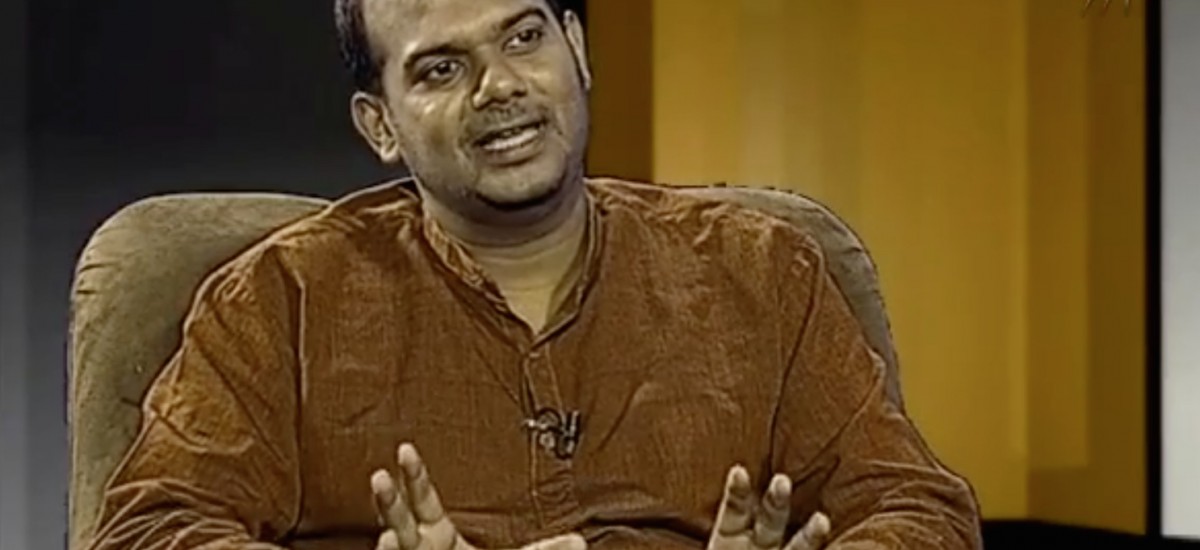Gihan de Chickera, who I’ve known since our halcyon days at S. Thomas’, is an actor, with experience in both stage and film productions, though perhaps even more loved and followed for his political cartoons, published in the Daily Mirror. Gihan is humble about his work to a point of fault and dare I say, for someone not unaccustomed to being on stage in front of hundreds, rather shy, which makes this interview – the first he’s done for TV – rather special, giving viewers a glimpse into a person that we only otherwise see as a character on stage, or as the creator of a gripping cartoon on a page.
We begin, as we must begin, by going into how Gihan got around to nurturing his aptitude for drawing when he was around 10 years old. Gihan puts it down to his elder sister (renowned theatre director Ruwanthie de Chickera), and drawings first inspired by Asterix and Tin Tin comics, and subsequently by the great Wijesoma’s cartoons that appeared in The Island. Gihan goes into why he kept drawing cartoons, and why he now does it for a living.
We talk about how Gihan developed his critical gaze, which in addition to drawing skills, is what makes an editorial or political cartoonist tick. Looking at how his own skills have developed over time, Gihan talks about how with maturity, the political cartoonist focuses on not just what is said by political and other leaders, but also what remains unsaid.
We then go into the actual production of a cartoon and how Gihan still likes to draw using his hand, and also uses digital tools like Adobe Illustrator and Photoshop in the process of production. He is asked whether cartoonists in the future will continue to physically draw (on paper), or if he belongs to the last generation that will not use digital tools from initial concept and production to final publication.
Gihan is asked whether he has got any pushback for what and who he’s depicted in his cartoons. When asking him this question, I had in mind the fact that not a single cartoonist in Sri Lanka has depicted, much less lampooned, the brutish Defence Secretary Gotabaya Rajapaksa. Gihan’s answer is an interesting one, suggesting that cartoonists have the space to critique polity and society to a greater degree than others in the media. “For all our faults”, he says “we Sri Lankans can laugh at ourselves”. He also talks about how visual metaphors and innuendo, in the service of political cartoons, can help get a message across that in another form may be censored, or result in violent reprisals.
Gihan also notes how even though it’s been the worst of times for journalism in Sri Lanka, political cartoons in particular have seen a healthy growth.
We go on to talk about whether Gihan in particular, and a political cartoonist in general, is more reactionary or revolutionary. In response, Gihan goes into how editorial and political cartoons are very different to journalism, in that they don’t have to give equal weight to all sides or perspectives of what they choose to depict.
Given Gihan’s talent on stage, we switch gears to theatre, and begin by looking at why contemporary Sinhala theatre, to a far greater extent than English theatre, robustly and creatively tackles challenging and contentious political issues. Gihan struggles to answer this, but in the next couple of minutes, he does touch upon some very interesting differences between the two theatre traditions, including the socio-economic backgrounds of the creators, the audiences they play to and the economics of theatrical productions. On that last point, Gihan is asked how theatre can be, in his words, “made more economically accessible to people without compromising on quality”.
Gihan played a lead role in (the brilliant) Machan, yet is on record as saying that he prefers the stage to film. When asked why, he goes into how as an actor, the process of producing a play for him is more appealing than preparing for a role in a film.
Given that Gihan is unique – in that he is an experienced actor as well as gifted cartoonist – he is asked whether the two talents fertilise each other, or whether they are very different aspects of his life that he keeps separate from each other.
Towards the end of our brief conversation, we talk about the Cartoonist of the Year award, which Gihan won in 2012, for his work over 2011. Gihan shares his feelings about the award and whether such awards help, in any way, to increase the appeal and reach of his work in print. Gihan also talks about the team of cartoonists at the Daily Mirror newspaper, and how their approach is different to the common perception of cartoonists as being solitary individuals, drawing away in isolation.
Gihan is asked whether, in drawing so frequently what he chooses to focus on, he doesn’t get depressed by the issues, individuals and institutions he chooses to depict.
His answer is an interesting one.

